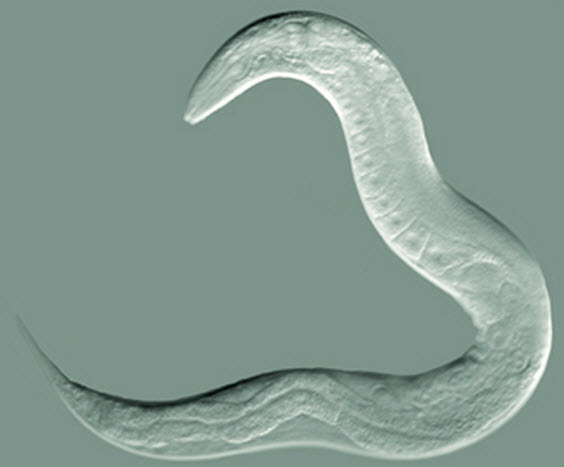Five-fold lifespan extension in C. Elegans by combining mutants
Research highlights possibility of combination therapy for aging; worms lived to the human equivalent of 400 to 500 years
December 16, 2013
[+]
New research published published online in Cell Reports on December 12, 2013 (open access) with the nematode C. elegans suggests that combining mutants can lead to radical lifespan extension.
C elegans nematode (credit: The Goldstein Lab)
Scientists at the Buck Institute combined mutations in two pathways well known for lifespan extension and report a synergistic five-fold extension of longevity — these worms lived to the human equivalent of 400 to 500 years — introducing the possibility of combination therapy for aging and the maladies associated with it.
The mutations inhibited key molecules involved in insulin signaling (IIS) and the nutrient signaling pathway Target of Rapamycin (TOR). Lead scientist and Buck faculty Pankaj Kapahi, PhD, said single mutations in TOR (in this case RSKS-1) usually result in a 30 percent lifespan extension, while mutations in IIS (Daf-2) often result in a doubling of lifespan in the worms — added together they would be expected to extend longevity by 130 percent.
“Instead, what we have here is a synergistic five-fold increase in lifespan,” Kapahi said. “The two mutations set off a positive feedback loop in specific tissues that amplified lifespan.
Combination therapies for aging
Kapahi said the research points to the possibility of using combination therapies for aging, similar to what is done for cancer and HIV. “In the early years, cancer researchers focused on mutations in single genes, but then it became apparent that different mutations in a class of genes were driving the disease process,” he said.“The same thing is likely happening in aging.”
Kapahi said this research could help explain why scientists are having a difficult time identifying single genes responsible for the long lives experienced by human centenarians. “It’s quite probable that interactions between genes are critical in those fortunate enough to live very long, healthy lives.”
Former Buck postdoctoral fellow Di Chen, PhD, now an associate professor at the Model Animal Research Center, Nanjing University, China, lead author of the study, said that the positive feedback loop (DAF-16 via the AMPK complex) originated in the germline tissue of worms. The germline is a sequence of reproductive cells that may be passed onto successive generations. “The germline was the key tissue for the synergistic gain in longevity — we think it may be where the interactions between the two mutations are integrated,” Chen said. “The finding has implications for similar synergy between the two pathways in more complex organisms.”
Kapahi said ideally the research would move into mice as a way of determining if the lifespan-extending synergy extends into mammals. “The idea would be to use mice genetically engineered to have suppressed insulin signaling, and then treat them with the drug rapamycin, which is well-known to suppress the TOR pathway.”
Other institutions involved include the School of Public Health, University of California, Berkeley and the Institute of Traditional Chinese and Western Medicine, Huashan Hospital, Fudan University, Shanghai. The work was supported by the National Institutes of Health, the American Federation for Aging Research, and the Hillblom Foundation.
Abstract of Cell Reports paper
Inhibition of DAF-2 (insulin-like growth factor 1 [IGF-1] receptor) or RSKS-1 (S6K), key molecules in the insulin/IGF-1 signaling (IIS) and target of rapamycin (TOR) pathways, respectively, extend lifespan in Caenorhabditis elegans. However, it has not been clear how and in which tissues they interact with each other to modulate longevity. Here, we demonstrate that a combination of mutations in daf-2 and rsks-1 produces a nearly 5-fold increase in longevity that is much greater than the sum of single mutations. This synergistic lifespan extension requires positive feedback regulation of DAF-16 (FOXO) via the AMP-activated protein kinase (AMPK) complex. Furthermore, we identify germline as the key tissue for this synergistic longevity. Moreover, germline-specific inhibition of rsks-1 activates DAF-16 in the intestine. Together, our findings highlight the importance of the germline in the significantly increased longevity produced by daf-2 rsks-1, which has important implications for interactions between the two major conserved longevity pathways in more complex organisms.
(¯`*• Global Source and/or more resources at http://goo.gl/zvSV7 │ www.Future-Observatory.blogspot.com and on LinkeIn Group's "Becoming Aware of the Futures" at http://goo.gl/8qKBbK │ @SciCzar │ Point of Contact: www.linkedin.com/in/AndresAgostini
 Washington
Washington